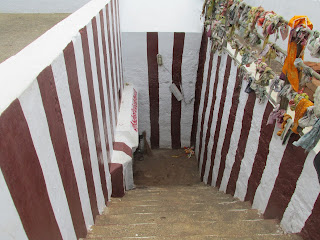Shiva who became a female deity
This article does not delve into the mythological tale of Shiva's gender transformation. Instead, it focuses on the transformation of a Shiva Linga into a female deity by the local community.



As the local villagers assumed stewardship of the modest Shiva temple concealed within the Chembarampakkam Reservoir's structure, they chose to name it Kanni Amman. Today, the Shiva Linga has been adorned with a nose and eyes, resembling a Mukha Linga, to symbolize its transformation into Kanni Amman. :-)

The Chembarampakkam Reservoir, one of Chennai city's two river-fed reservoirs, is situated approximately 30 kilometers from Chennai Central. Prior to the reservoir's construction, it is likely that there stood a temple dedicated to Lord Shiva along the banks of Chembarampakkam Lake. Following the reservoir's completion, access to this small temple likely became more challenging. As the temple gradually fell into neglect and obscurity, it was the local villagers who continued to venerate it, now concealed within the reservoir's structure. These villagers appear to have reimagined the deity as a female figure, christening her Kanni Amman.

But who exactly is Kanni Amman? In Tamil Nadu, village deities are often referred to as "Kanni," meaning "virgin." Serpents are honored as Naga Kannis, and the Sapta Matrikas, typically found in traditional temples, are revered as Sapta Kannis. At times, Mari Amman is also known as Mundaka Kanni. Thus, the practice of naming female village deities as "Kanni" seems to be a widespread tradition in the state of Tamil Nadu.
Besides Mundaka Kanni, Naga Kanni, and Sapta Kanni, numerous village temples across Tamil Nadu have "Kanni Amman" as their principal deity. However, the exact identity of Kanni Amman remains elusive, with no definitive sources available. To the best of my knowledge, Chamunda Devi, one of the Sapta Matrikas (or Kannis), enjoys greater popularity than her six counterparts. She is occasionally equated with Kali and has temples both within and outside Tamil Nadu. Even in temples where all seven Devis are worshiped, Chamunda often holds a prominent position in certain village temples. Therefore, it is plausible to infer that "Kanni Amman" may refer to Chamunda (also known as Kali, Chamundi, etc.).

As the local villagers assumed stewardship of the modest Shiva temple concealed within the Chembarampakkam Reservoir's structure, they chose to name it Kanni Amman. Today, the Shiva Linga has been adorned with a nose and eyes, resembling a Mukha Linga, to symbolize its transformation into Kanni Amman. :-)



.JPG)
Comments
Post a Comment